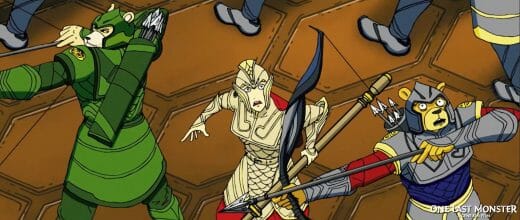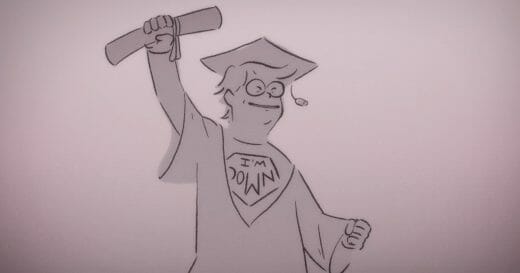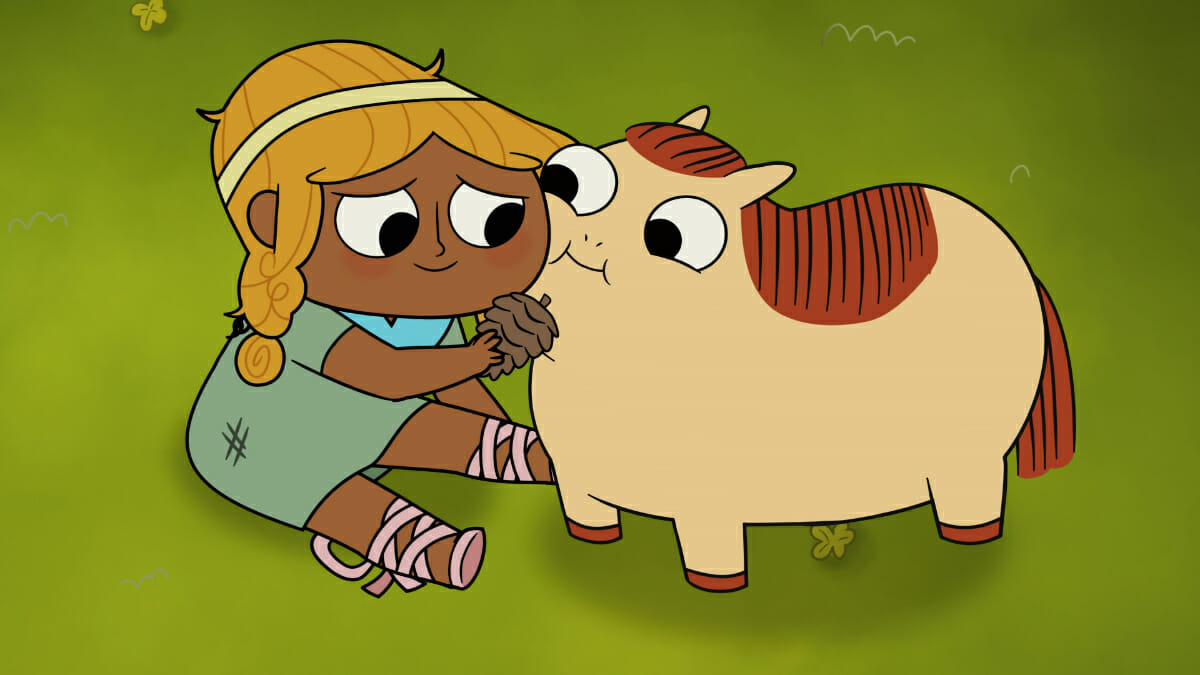
Pinecone & Pony is a new series that follows the adventures of a young girl named Pinecone, and her cute, flatulent pony. Together, Pinecone and her pony explore what it means to be a warrior and how to challenge expectations. The series draws from cartoonist Kate Beaton’s picture book, The Princess and the Pony. The team at Atomic Cartoons worked with Kate and DreamWorks Animation to adapt her book as an animated series, which premiered on Apple TV+ in April 2022.
We caught up with the Atomic Cartoons team — including Wayne-Michael Lee (series director), Dana Rose (producer), Keith Chamberlain (builds supervisor), Nadine Westerbarkey (studio creative director) and Joel Bradley (head of production) — to learn more about the creative decisions and production process that went into the series.
How familiar was the Atomic Cartoons team with Kate Beaton’s work before starting production on Pinecone & Pony?
Nadine: There is quite a fanbase for Kate Beaton’s work at Atomic Cartoons, and so there was tons of excitement for the opportunity to collaborate so closely with Kate on this project. Everyone at Atomic had a shared dedication to staying true to the spirit and core of her work in Pinecone & Pony.
Wayne: I have long been a huge fan of Kate’s work. Back when Kate was doing Hark, a Vagrant, I used to attend her panels at the Toronto Comic Arts Festival. I never imagined that I would have the chance to work on a show created by her, because that idea was truly a dream. When I interviewed for the role of series director, I met Kate for the first time. That was almost an out of body experience for me; I couldn’t believe it was actually happening!
Dana: I actually wasn’t that familiar with Kate’s work, but it didn’t take long to convert me into a fan. Early into making the series I shared her work with my family, and now we are all fans! And not just of Pinecone & Pony; we appreciate all of her work.
Our whole team has been talking about the articles about our show’s representation/diversity today, it’s really nice to be noticed for something that meant a lot to us! Here are some of the people you will meet when you watch Pinecone and Pony, lead character designer @vevansart pic.twitter.com/2lnbVtswNR
— Kate Beaton (@beatonna) May 24, 2022
What was it like to collaborate with Kate Beaton on the series?
Nadine: We worked much more closely with Kate than we have on other projects where we’ve collaborated with a creator. What stood out to me right at the start was that Kate’s priority was to set up a team together with Wayne that catered towards diversity and inclusion, and making this project really meaningful for everyone involved. The focus on balance and collaboration was very unique on this project.
Wayne: Showrunner Stephanie Kaliner, Kate and I worked very closely throughout the production of the series. Right at the start, Kate told us that the book was its own thing, and she wanted us to take the concept and story and evolve it into something our own. Kate wasn’t beholden to making the series an exact copy of the book, and this meant there was space for us to creatively develop the story, characters, and world of Pinecone & Pony beyond the scope of the book. Kate wasn’t at all precious about aspects of her original work. She was open to our ideas, which made it really fun creatively.
Dana: Working with Kate was so wonderful. She has such a kind heart. I noticed that she was always checking in with the team to make sure that every artist was feeling good about the project. Everyone really appreciated how much care she had not just for the series itself, but for the people involved in it.
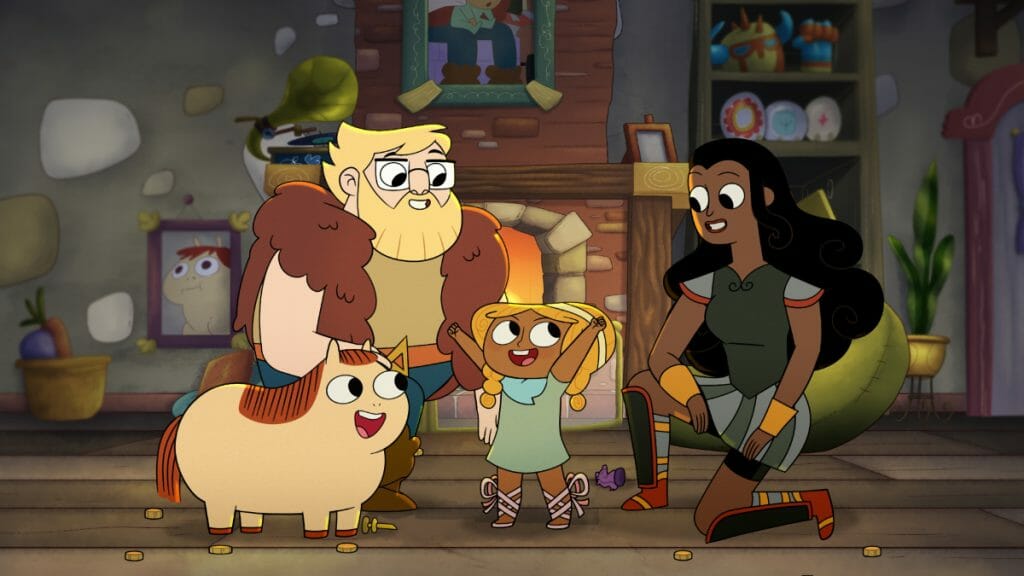
Can you tell us about the team behind the series, and what the production timeline has been like?
Dana: Over the course of a year and a half we created thirty-two 11-minute long episodes. Putting the team together for this was an interesting process because this was the first pre-to-post project for Atomic Cartoons Ottawa. This meant we were ramping up hiring in a number of departments. But we were also right in the middle of COVID-19 lockdowns. Normally we would hire a team limited to Ottawa, but because we were working from home, we were able to hire people from all over Ontario. Rather than working in-person, we worked entirely over video calls.
Wayne: Right at the start of production I had just moved, and I was stepping into my first role as a series director. Not only that, but I was series director on a project that involved a creator I really appreciate and idolize. As you can imagine, it was a bit overwhelming. Luckily, the team was able to collaborate well even though we weren’t all in a room together. Steph, Kate and I seemed to have a mind-meld all throughout production. We were completely on the same page about what we wanted for the series.
I loved drawing these guys pic.twitter.com/z0ZFcvgja3
— Kate Beaton (@beatonna) May 24, 2022
How similar or different was Pinecone & Pony to other productions that you worked on?
Nadine: What really made this production stand out to me was how collaborative it was. But it was also because the series is a hybrid mix of comedy and action. Combining those styles together and then casting a team that can carry it can be a challenge.
Wayne: Yes, with Pinecone & Pony we dabbled in a lot of different genres. We even included a spooky, horror-themed episode. Bouncing between comedy and action was a challenge because we had to make sure that characters could transition well between those genres.
Dana: What’s great is that we were able to maintain character development and growth throughout the episodes. And mixing genres meant we could deliver the lessons of the episodes in unique and meaningful ways, without following a strict formula for every episode. The takeaways for each episode weren’t always blatantly obvious, which is what we wanted. We took a creative approach to delivering messages about personal growth. It was refreshing to see a kids animated show delve into this realm because it made the series something more than just an educational series.
Wayne: I’ll add that working on Pinecone & Pony was also tons of fun. I laugh when I think about some of our production gags. For example, at the start of production we instated what we call the “one toot rule.” In the original book, Pony is known to fart a lot. Even though we had the rule, we often had a laugh because the board artists would go overboard with Pony’s toots, and we’d have to remove a couple toots so there’s just one per episode.
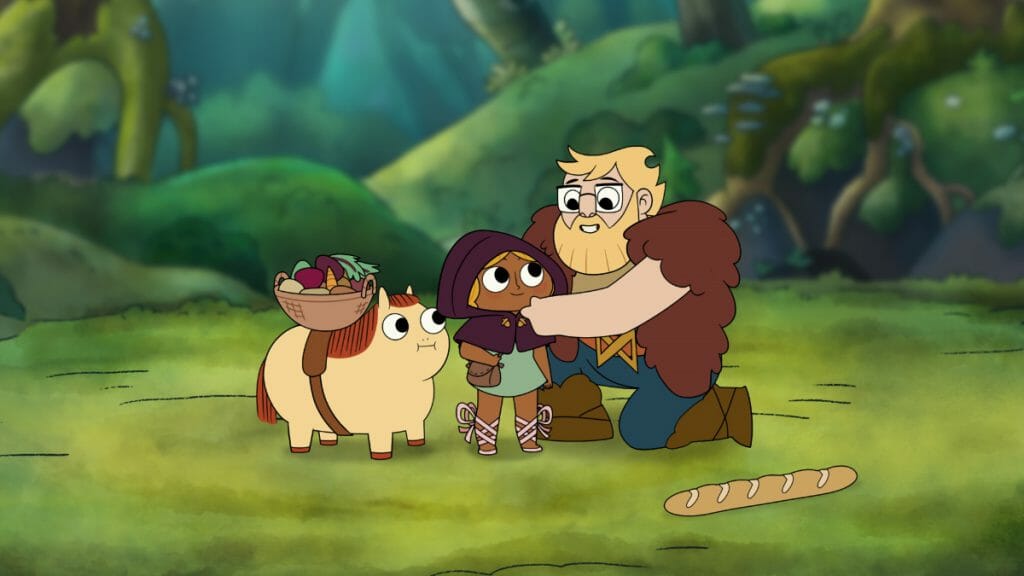
Can you share a bit about the look of Pinecone & Pony, and the fantasy world that the characters explore?
Wayne: When establishing the look of the show, our art director Laura Bifano took on the challenge of having the series look like it came from a kid’s storybook, mixed with a classic animated series look, and with a slight nod to medieval history.
We didn’t want to nod too heavily at traditional medieval fantasy as that can be very Euro-centric. So we decided, with Kate and Steph, to expand that idea a bit and look at other cultures for inspiration and for further representation in the world of Sturdystone.
We wanted this fantasy world to feel like it was truly a world through the eyes of a kid. Because of this, we didn’t stick to a historically accurate medieval world. When a kid thinks about the past, they likely don’t think about it in a formally historical way. For example, in Pinecone & Pony sometimes characters will have modern items, like, they’d be wearing running shoes, or have board games. It was fun to play around with this!
Pinecone & Pony has been out for a bit so I thought I’d share some of my favourite designs I did when I was the lead character designer for the show! pic.twitter.com/NHxg4rUanO
— ? Victoria Evans ? (@vevansart) April 20, 2022
The characters in Pinecone & Pony have diverse characteristics and bodies. How did you approach adapting characters from a children’s book to an animated series?
Wayne: There are several characters in the series that don’t exist in the book. By creating new characters, we had an opportunity to represent various body types. We brought in consultants to help us do this as responsibly as possible. We had an Indigenous consultant, Christopher Auchter, who helped in designing Celestia and Peregrine. And we had a mobility consultant, Kirsten Sharp, who informed us on how to animate Celestia.
Dana: We also consulted team members internally for representation tips. For example, our colleagues helped us understand how to animate different types of hair in an accurate way. Having that internal guidance was a new experience, and very welcomed.
How did your team approach rigging characters for the series? Did you use new techniques in Harmony for rigging, animation, or compositing?
Keith: Yes, we built the characters using Harmony Premium, version 20, if I remember correctly. We kept a similar approach to what we do on most Atomic series, which we refer to as Seamless. Creating overlapping parts that will in-between from one view to the next of the character; rather than separate groups for each angle, such as front, quarter front, profile and so on.
A new technique for the series was the setup of mouth shapes; which were created using deformers. This allowed the animation team to fully in-between the parts of the mouth: Tongue, teeth, lips etc. This replaced the usual cell swap mouth charts and has become standard practice at Atomic. Using this approach meant we also had to further develop our use of Master Controllers to establish key mouth shapes for consistent lip synch.
I wanted to share some of the creature designs that I did for Pinecone and Pony! They gave me a lot of freedom with these, and I had a lot of fun! This team was such a dream to be a part of! pic.twitter.com/8DXKkWImNc
— Haley Rose ? lightbox expo 710 (@haleyrose_art) April 23, 2022
What was the most challenging part of rigging the series’ characters, and how did you overcome that challenge?
Keith: One of the most difficult parts for the series was Pinecone’s hair. Her ponytails, fringe, and curls were very difficult to set up and create a hierarchy for. The greatest boon to solving this problem was being able to work directly with the designers and have a back and forth with minor look changes and refining the turnaround design to be as accurate as possible. This isn’t normally the case with doing service work where approved designs are received from clients and are often set in stone.
There were some challenges for the animators along the way. For the builders this led the team to adopting a setup created at our Vancouver studio, referred to as ‘Sticky-Z,’ which is a workaround that constrains the levelling of cut objects in the render view.
Do you have advice for artists interested in working on a series like Pinecone and Pony?
Wayne: It’s important to be willing and open to change because projects like this often change along the way. For example, this series started out as being for preschool-aged children, but we ended up creating an epic adventure series for older kids instead. You can’t be beholden to a single concept or idea, because especially in a collaborative project like this, ideas evolve.
Dana: From a production standpoint, it’s all about embracing the collaborative process. There were over 100 sets of hands involved in making this series, so it was truly a team effort. You can’t get to the finish line of any project without collaboration between not just the artists involved, but the clients and broadcasters on the project.
The first Greymoon sketch was a white dude who felt too generic Wizard-like, the second was like “oh there I see him” and the third one, there he was pic.twitter.com/vm14YVOgWU
— Kate Beaton (@beatonna) May 24, 2022
What’s next for the series?
Dana: We’re hoping for a third season! Throughout making the episodes for season 1 and 2, our showrunner, Stephanie, took plenty of notes for a third season. But, there’s no word yet on whether Apple TV+ is on board. But don’t worry, either way there’s 8 more episodes to come!
Wayne: We’re super-excited with how well the show has been received. And there’s so many more stories to tell within the series, so hopefully we get signed on for more!
Nadine: It’s been great to see continued attention on Pinecone & Pony. In fact, later this year Wayne and I will be on a panel at the Ottawa International Animation Festival to talk about the series.
Can you tell us about any exciting projects that Atomic Cartoons has coming up?
Nadine: I wish we could share all of our upcoming projects with you, because all of them are exciting! But there’s two in particular that I can talk about right now. FXX will soon be broadcasting Little Demon, which is a new adult animated series that is a mix of horror and comedy. And, Oddballs, which is a comedy based on the work of YouTube creator James Rallison, is coming soon to Netflix!
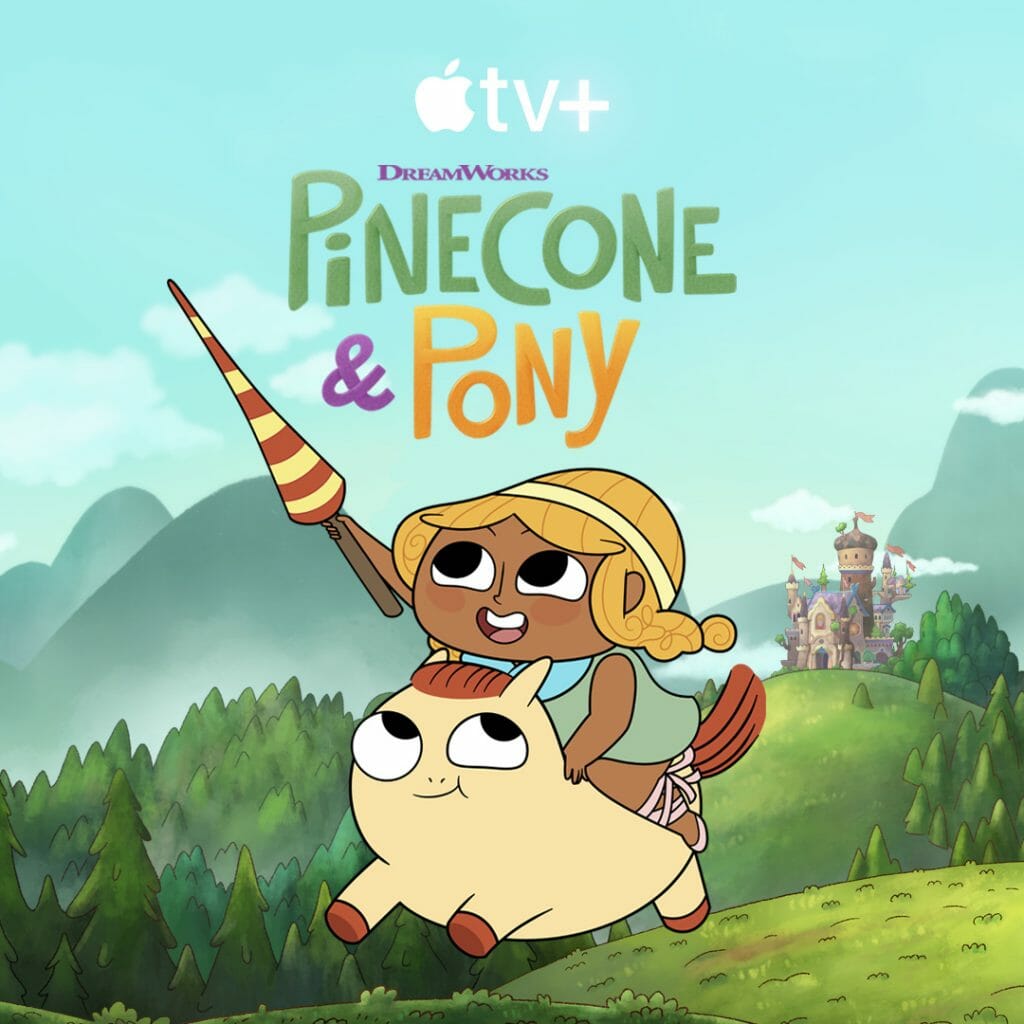
- Want to see more of Pinecone & Pony? The series is currently streaming on Apple TV+.
- Interested in joining the team at Atomic Cartoons? You can find the studio’s recruitment page here.


